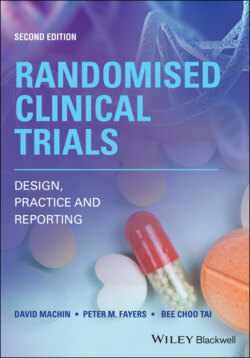Читать книгу Randomised Clinical Trials - David Machin - Страница 38
1.6 History
ОглавлениеProbably the single most important contribution to the science of comparative clinical trials was the recognition by Austin Bradford Hill (1897–1991) in the 1940s that patients should be allocated the options under consideration at random so that comparisons should be free from bias. Consequently, the first randomised trial was planned to test the value of a pertussis vaccine to prevent whooping-cough and the results of which were subsequently published by the Medical Research Council Whooping‐Cough Immunization Committee (1951). He later stated: ‘The aim of the controlled clinical trial is very simple: it is to ensure that the comparisons we make are as precise, as informative, and as convincing as possible’. This development by itself may not have led to more theoretically based statistical innovation directly, but was the foundation for the science of clinical trials.
Nevertheless, the history of clinical trials research precedes this important development by many years. Thus, clinical trials were mentioned by Avicenna (980–1037) in his The Canon of Medicine (1025) in which he laid down rules for the experimental use and testing of drugs and wrote a precise guide for practical experimentation in the process of discovering and proving the effectiveness of medical drugs and substances. His rules and principles for testing the effectiveness of new drugs and medications are summarised in Figure 1.4, and these still form the basis of modern clinical trials.
One of the most famous clinical trials was that conducted by James Lind (1716–1794) in 1747. He compared the effects of various different acidic substances, ranging from vinegar to cider, on groups of sailors afflicted by scurvy and found that the group who were given oranges and lemons had largely recovered from their scurvy after 6 days. Somewhat later, Frederick Akbar Mahomed (1849–1884) founded the Collective Investigation Record for the British Medical Association. This organisation collated data from physicians practising outside the hospital setting and was an important precursor of modern collaborative clinical trials.
The conduct of clinical trials research is multidisciplinary in nature so that a team effort is always needed from the concept stage, through design, conduct, monitoring and reporting. This collaborative effort has led not only to medical developments in many areas but to developments of a more statistical nature. Thus, for those working in cancer and for whom survival was a key endpoint in the clinical trials the two seminal papers published by Peto, Pike, Armitage, et al. (1976, 1977) in the British Journal of Cancer marked a new era. These papers provided the template for key items essential to the design, conduct, analysis and reporting of randomised trials with emphasis on those requiring prolonged observation of each patient. In particular, these papers described the Kaplan and Meier (1958) estimate of the survival curve, logrank test and the stratified logrank test in such detail that any careful investigator could follow the necessary steps. A computer program (termed the Oxford program) had also been distributed (some time before the date of the publications themselves), and this allowed the methods suggested by the papers to be implemented. Certainly, for those working in data centres with responsibility for many (often reasonably large) trials, this program facilitated the analysis and helped to ensure that the ideas expressed in these articles were widely disseminated. These papers formed the basic text for those involved in clinical trials for many years and (besides making the ideas accessible to medical statisticians) their role in easing the acceptance of statistical ideas into the clinical community cannot be underestimated.
Figure 1.4 Avicenna’s rules for the experimental use and testing of drugs
It should not go unnoticed that David Roxbee Cox was one of the authors of the seminal papers referred to above although his paper describing the proportional‐hazards regression model appeared some 4 years earlier (Cox, 1972). His paper was presented at a discussion meeting of the UK Royal Statistical Society and subsequently published in Series B of the Society’s journals. This journal deals with the more theoretical aspects of statistical research and does not make easy reading for many statisticians and would not be one to which clinical teams might readily refer. Despite this, this particular paper is probably one of the most cited papers in the medical literature. In brief, the methodology leads to easier analysis of trials with survival time endpoints that include stratification in their design and/or baseline patient characteristics at the time of randomisation which may affect prognosis.
As we have indicated, EBM requires that it is important to critically assess all the available evidence about whether an intervention works. Thus, systematic overviews have become a vital component of clinical trial research and are routinely applied before launching new trials as a means of confirming the need to carry out a clinical trial or after completing trials as a means of synthesising and summarising the current knowledge on the topic of interest. These reviews are the focal interest of the Cochrane Collaboration, and the associated handbook by Higgins, Thomas, Chandler, et al. (2019) provides the key to their implementation.
Some developments have not depended on technical advancement (although there are always some) such as the now standard practice of reporting confidence intervals rather than relying solely on p‐values at the interpretation stage. Of major importance over this same time period has been the expansion in data processing capabilities and the range of analytical possibilities only made feasible by the amazing development in computer power. Despite many advances, the majority of randomised controlled trials remain simple in design – most often a two‐group comparison.
